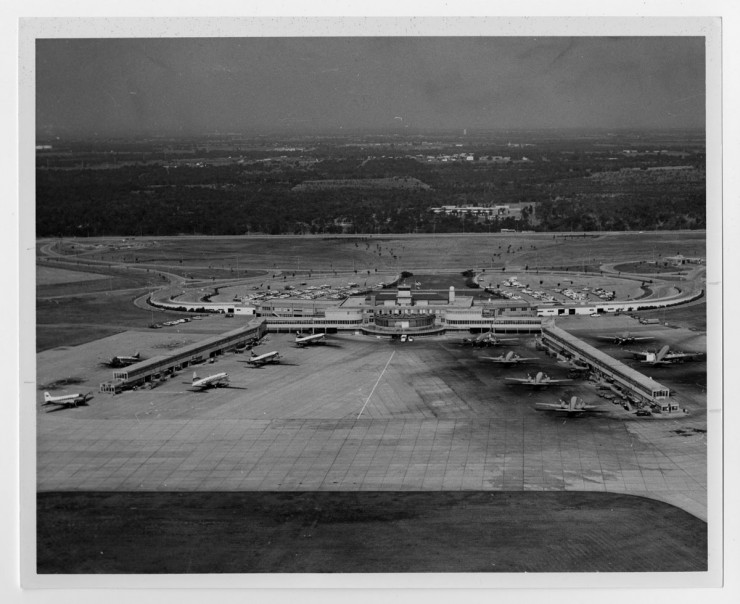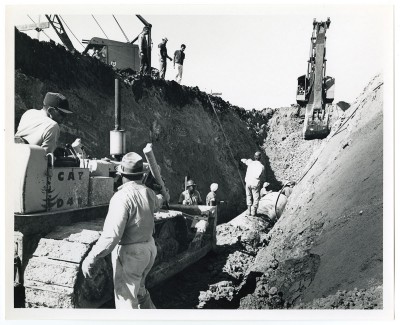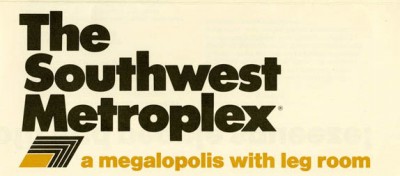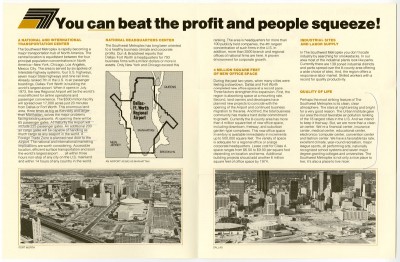
Aerial view of the Dallas-Fort Worth Regional Airport from the Lester Strother Texas Metro Magazine collection
Dallas and Fort Worth share such a strong rivalry, it’s somewhat of a surprise they’ve been able to work together on some of the most exciting infrastructure projects in North Texas. Take the DFW Regional Airport, for example. Both cities operated their own airports quite successfully for a time–Meacham Field in Fort Worth and Love Field in Dallas. However, these airports were not ready to accommodate the larger airliners that began arriving in the 1930s, nor the expected rise in population.

Construction workers at the Dallas-Fort Worth Regional Airport site, from the Lester Strother Texas Metro Magazine collection
Fort Worth and Dallas each sought to make necessary renovations by asking the Civil Aeronautics Administration for financial assistance, but the CAA was preoccupied with finding an airfield in DFW for army use. Love Field was expanded through a bond program, and Meacham Field was transitioned into the Greater Fort Worth International Airport, or Amon Carter Field.
While both cities had suggested at different times to cooperate with each other in developing a shared airport, the timing was never right. In 1961, however, it became clear that the federal government wanted Dallas and Fort Worth to work together in establishing a new airport, rather than continuing to renovate the outdated ones. From this, the Dallas/Fort Worth Regional Airport Board was formed, and plans began to materialize.

From “The Southwest Metroplex: A Megalopolis with Leg Room,” from the Lester Strother Texas Metro Magazine collection
The Airport Board drafted plans for a world-class airport hub that would have several design breakthroughs, making it a comfortable place for passengers and a profitable place for airlines. Plans included a high-speed spine roadway with localized spin-off parking, which would allow passengers to quickly arrive at the destination appropriate to their needs, whether that be picking up a passenger, dropping off a passenger, or parking and going into the building. The terminals were also planned to be circular in shape, which would allow for better airplane access and visibility. The airport would also implement a computerized multi-terminal transit system for passengers and baggage.

Interior of “The Southwest Metroplex: A Megalopolis with Leg Room,” from the Lester Strother Texas Metro Magazine collection
When the airport opened in 1974, there were still plans to continue expanding well into the 21st century. This was due to the anticipated population growth in the Southwest Metroplex, which this pamphlet describes as a “megalopolis with leg room.” Today, the airport covers nearly 27 square miles, operates 165 gates, 7 runways, and plays host to approximately 174,000 passengers a day.
The Lester Strother Texas Metro Magazine collection offers more information about the planning and construction of the DFW Airport. Texas Metro was founded largely to promote the airport and the Southwest Metroplex as a whole. The collection also contains materials from other urban planning and infrastructure projects in North Texas.
-by Alexandra Traxinger Schütz



Leave a Reply